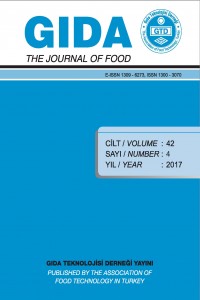Abstract
Bu
çalışmada 13 adet eşek sütünün kimyasal özelliklerinden kuru madde (%), yağ (%),
pH ve titrasyon asitliği (˚SH) değerleri belirlenmiştir. Mikrobiyolojik
analizlerden toplam aerobik mezofil bakteri (TAMB), laktik asit bakterileri
(LAB), koliform grup bakteri, enterokok, stafilokok/ mikrokok ve Staphylococcus aureus analizleri
gerçekleştirilmiştir. Eşek sütünün protein profili Sodyum Dodesil Sulfat
Poliakrilamid Jel Elektroforezi (SDS-PAGE) yöntemi ile belirlenmiştir. Eşek
sütlerinde pH, titrasyon asitliği, kuru madde ve yağ değerleri sırasıyla
7.16-7.62, 2.0-3.5, 8.42-9.82, 0.40-0.95 aralıklarında değişim göstermiştir.
Örneklerin toplam mezofil aerob bakteri sayısı 3.12-7.48 log kob/mL, laktobasil
ve laktokok sayısı 3.35-5.58 log kob/mL, 4.3-6.93 log kob/mL, enterokok
3.55-5.01 log kob/mL, koliform grup bakteri sayısı 3.51-6.45 log kob/mL, stafilokok/mikrokok
sayısı 3.53-6.31 log kob/mL olarak saptanmıştır. Tüm süt örneklerinde Staphylococcus aureus'a rastlanmamıştır.
References
- Clare DA, Swaisgood HE. 2000. Bioactive Milk Peptides: A Prospectus. J Dairy Sci, 83(6): 1187-95.
- Bidasolo BI, Ramos M, Gomez-Ruiz JA. 2012. In Vitro Simulated Gastrointestinal Digestion of Donkeys’ Milk. Peptide Characterization by High Performance Liquid Chromatography tandem MassSpectrometry. Int Dairy J, 24: 146-152.
- Zhang X, Zhao L, Jiang L, Dong M, Ren F. 2008. The Antimicrobial Activity of Donkey Milk and Its Microflora Changes During Storage. Food Control, 19: 1191-119.
- Anon 2002. TS 1018 “İnek Sütü-Çiğ”, Türk Standartlar Enstitüsü, Ankara.
- Halkman AK (ed). 2005. Gıda Mikrobiyolojisi Uygulamaları. Başak Matbaacılık Ankara, Türkiye, 358 p.
- Laemmli UK. 1970. Cleavage of Structural Protein During the Assembly of the Head of Bacteriophage T4. Nature, 227: 680-685.
- Salimei E, Fantuz F, Coppola R, Chiofalo B, Polidori P, Varisco G. 2004. Composition and Characteristics of Ass’s Milk. Anim Res, 53: 67-78.
- Di Renzo GC, Altieri G, Genovese F. 2013. Donkey Milk Powder Production and Properties Compared to Other Milk Powders. Int J Dairy Sci Technol 93 (4-5 SI): 551-564.
- Doreau M, Martin-Rosset W. 2002a. Dairy Animals: Horse. Inh.Roginski, J. A. Fuquay, P. F. Fox (Eds.). In: Encyclopedia of Dairy Sci, London, UK:Academic Press, pp 630-637.
- Guo HY, Pang K, Zhang XY, Zhao L, Chen SW, Dong ML, Ren FZ. 2007. Composition, Physiochemical Properties, Nitrogen Fraction Distribution, and Amino Acid Profile of Donkey Milk. J Dairy Sci, 90: 1635-1643.
Abstract
In this study, dry matter (%), fat (%), pH and
titratable acidity (˚SH) values were determined from chemical properties of 13
donkey's milk. Total aerobic mesophilic bacteria (TAMB), lactic acid bacteria
(LAB), coliform group bacteria, enterococci, staphylococcus/micrococcus and Staphylococcus aureus analyses were
performed. Donkey's milk protein profile
determined by sodium dodecyl sulfate polyacrylamide gel electrophoresis
(SDS-page) method. pH, titratable acidity, dry matter and fat values ranged
from 7.16 to 7.62, 2.0 to 3.25, 8.42 to 9.82, 0.40 to 0.95 respectively. The
total mesophilic aerob bacteria counts of the samples were determined 3.12-7.48
log-cfu/mL, Lactobacilli and Lactococci 3.35-5.58
log-cfu/mL, 4.3-6.93 log-cfu/mL,
Enterococci spp 3.55-5.01 log-cfu/mL, Coliform group bacteria counts 3.51-6.45
log-cfu/mL and Staphylococcus/micrococcus
3.53-6.31 log-cfu/mL. Staphylococcus
aureus was not detected in all milk samples.
References
- Clare DA, Swaisgood HE. 2000. Bioactive Milk Peptides: A Prospectus. J Dairy Sci, 83(6): 1187-95.
- Bidasolo BI, Ramos M, Gomez-Ruiz JA. 2012. In Vitro Simulated Gastrointestinal Digestion of Donkeys’ Milk. Peptide Characterization by High Performance Liquid Chromatography tandem MassSpectrometry. Int Dairy J, 24: 146-152.
- Zhang X, Zhao L, Jiang L, Dong M, Ren F. 2008. The Antimicrobial Activity of Donkey Milk and Its Microflora Changes During Storage. Food Control, 19: 1191-119.
- Anon 2002. TS 1018 “İnek Sütü-Çiğ”, Türk Standartlar Enstitüsü, Ankara.
- Halkman AK (ed). 2005. Gıda Mikrobiyolojisi Uygulamaları. Başak Matbaacılık Ankara, Türkiye, 358 p.
- Laemmli UK. 1970. Cleavage of Structural Protein During the Assembly of the Head of Bacteriophage T4. Nature, 227: 680-685.
- Salimei E, Fantuz F, Coppola R, Chiofalo B, Polidori P, Varisco G. 2004. Composition and Characteristics of Ass’s Milk. Anim Res, 53: 67-78.
- Di Renzo GC, Altieri G, Genovese F. 2013. Donkey Milk Powder Production and Properties Compared to Other Milk Powders. Int J Dairy Sci Technol 93 (4-5 SI): 551-564.
- Doreau M, Martin-Rosset W. 2002a. Dairy Animals: Horse. Inh.Roginski, J. A. Fuquay, P. F. Fox (Eds.). In: Encyclopedia of Dairy Sci, London, UK:Academic Press, pp 630-637.
- Guo HY, Pang K, Zhang XY, Zhao L, Chen SW, Dong ML, Ren FZ. 2007. Composition, Physiochemical Properties, Nitrogen Fraction Distribution, and Amino Acid Profile of Donkey Milk. J Dairy Sci, 90: 1635-1643.
Details
| Journal Section | Articles |
|---|---|
| Authors | |
| Publication Date | March 31, 2017 |
| Published in Issue | Year 2017 Volume: 42 Issue: 4 |



